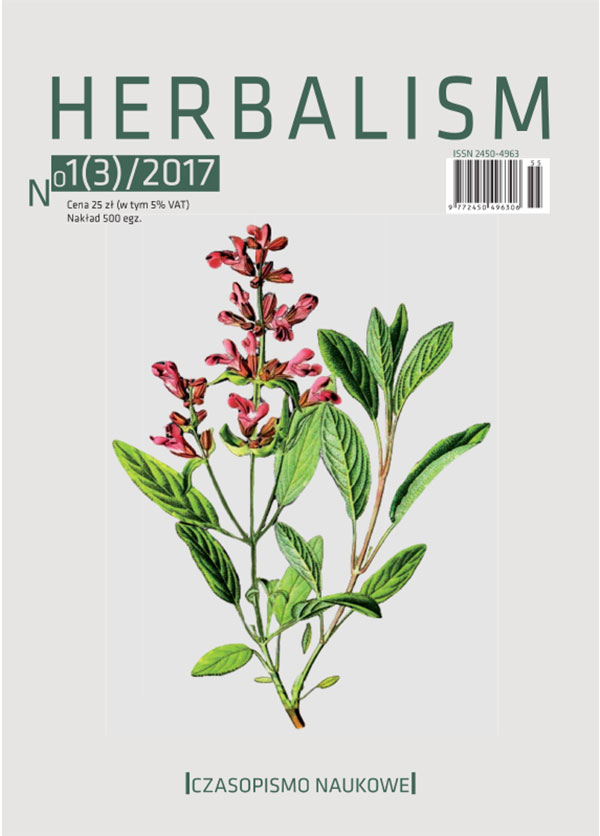Properties pro-health Flax (Linum ussitatissimum L.)
DOI:
https://doi.org/10.12775/HERB.2017.008Keywords
flax, flax seeds, flaxseed oil, cholesterolAbstract
Flax is a short-lived plant grown in temperate climates. The most common species is Linum usitatissimum. Linen is the raw material for the production of ropes and yarns, and today it is increasingly used in cosmetology and medicine. Flax seeds contain many valuable substances, important for human and animal health. Cold pressed linseed oil has valuable nutritional and health benefits. Flaxseed fatty acids contained in linseed oil have the ability to reduce plasma triacylglycerol levels, normalize blood pressure, act against the thrombosis, inhibit the development of coronary heart disease. They show anti-cancer effect and improve the condition of the skin and hair. Flaxseed dressings act as natural antibiotics. This article presents the results of the observation of the use of cold pressed linseed oil and flax seeds in human diets with elevated blood cholesterol. It can be inferred that the daily use of flax seed and cold-pressed linseed oil can help and significantly speed up the process of lowering cholesterol in the human body, which is associated with amarked improvement in physical condition and well-being.
References
Heywood V. H., Ball P. W., Leguminosae, [w:] Flora Europaea Vol. 2, (red.) T.G. Tutin I wsp., Cambridge University Press, Cambridge 1968.
Podbielkowski Z., Sudnik-Wójcikowska B., Słownik roślin użytkowych, PWRiL, Warszawa 2003.
Lauber K., Wagner G., Flora Helvetica, Haupt Verlag, Bern-Stuttgart-Wien 2007.
Zając M., Zając A., Elementy geograficzne rodzimej flory Polski, Instytut Botaniki Uniwersytetu Jagiellońskiego, Kraków 2009.
Zając A., Zając M. (red.), Atlas rozmieszczenia roślin naczyniowych w Polsce. Instytut Botaniki Uniwersytetu Jagiellońskiego, Kraków 2001.
Kostrakiewicz K., Rodzina: Papilionaceae, Motylkowate, [w:] Flora Polska. Rośliny Naczyniowe Polski i Ziem Ościennych. Tom VIII, (red.) W. Szafer i B. Pawłowski, Państwowe Wydawnictwo Naukowe, Warszawa 1959.
Rubilar M., Gutiérrez C., Verdugo M., Shene C., Sineiro J., Flaxseed as asource of functional ingredients, Journal of Soil Science and Plant Nutrition, 2010, 10(3) s. 373–377.
Hałubowicz–Kliza G., Integrowana produkcja lnu włóknistego, Wyd. Instytut Uprawy i Gleboznawstwa Państwowy Instytut Badawczy w Puławach, 2015, s. 32.
Zając T., Klima K., Borowiec F., Witkowicz R., Barteczko J., Plonowanie lnu oleistego w różnych warunkach siedliska, Rośliny Oleiste, 2002, 23, s. 275–286.
FAOSTAT., http://faostat3.fao.org/home/E. [Akces: marzec 2017 r.].
Mińkowski K., Studia nad stabilnością oksydatywną olejów roślinnych bogatych w polienowi kwasy tłuszczowe o budowie trienowej, Rozprawa habilitacyjna, Roczniki Instytutu Mięsnego i Tłuszczowego, 2008, s. 46.
Cichosz G., Czeczot H., Stabilność oksydacyjna tłuszczów jadalnych – konsekwencje zdrowotne, Bromatologia i Chemia Toksykologiczna, 2011, 1, s. 50–60.
Ryan C.D., Smyth, S.J., Economic implications of low-level presence in azero-tolerance Europeanimport market: The case of Canadian Triffid flax, AgBioForum, 2012, 15(1), s. 21–30.
Demirbas A., Production of biodiesel fuels from linseed oil using methanol and ethanol in noncatalytic SCF conditions, Biomass and bioenergy, 2009, 33, s. 113–118.
Tańska M., Rotkiewicz N., Ambrosiewicz-Walacki M., Wpływ warunków ogrzewania nasion lnu i lnianki na jakość olejów przeznaczonych do produkcji biodiesla, Nauka Przyroda Technologie, 2013, 7(4), s. 1–11.
Gunstone F. D., Vegetable oils in food technology, composition, properties and uses, Blackwell Publishing, 2000, s. 318–322.
Mannion C., Page S., Bell L.H., Verhoef M., Components of anticancer diet: dietary recommendations, restrictions and supplements of Bill Henderson Protocol, Review, Nutrients, 2011, 3, s. 1–26.
Reguła-Sardat A., Zając T., Zagrodzki P., Produkty funkcjonalne – tak, ale jaki kierunek?, Agrotrendy, 2008, 18(99), s. 32–33.
Marciniak-Łukasiak K., Rola i znaczenie kwasów omega-3, Żywność. Nauka. Technologia. Jakość, 6 (79), 2011, s. 24–35.
Achremowicz K., Szary-Sworst K., Wielonienasycone kwasy tłuszczowe czynnikiem poprawy stanu zdrowia człowieka, Żywność. Nauka. Technologia. Jakość, 2005, 3(44), s. 23–35.111.
Jurkowska S., Surowce kosmetyczne, Ośrodek Informatyczno-Badawczy „Ekoprzem” Sp. zo.o., Dąbrowa Górnicza 2007, s. 42.
Lamer-Zarawska E., Kowal-Gierczyk E., Niedworok J., Fitoterapia i leki roślinne, PZWL, Warszawa 2012, s. 21.
Walczak-Zeidler K., Felczak-Guzik A., Nowak I., Oleje roślinne stosowane jako surowce kosmetyczne – leksykon, Cursiva, Kostrzyn 2012.
Morris, M., Creating Value chain Cooperation, IDS Bulletin, 2001, 32(3), s. 127–136.
Bitiucka D., Sierżantowicz R., Problemy pielęgnacyjne pojawiające się w procesie gojenia ran nowotworowych, Pielęgniarstwo Polskie, 2016, 2(60), s. 241–246.
Skórkowska-Telichowska K., Kulma A., Szopa J., The response of diabetic foot to a new type of dressing, International Archives Medicine, 2012, 5, s. 33.
Szopa J., Wrób-Kwiatkowska M., Kulma A., Żuk M., Skórkowska-Telichowska K., Dymińska L., Mączka M., Hanuza J., Żebrowski J., Preisner M., Chemica composition
and molecular structure of fibers from transgenic flax producing polyhydroxybutyrate, and mechanical properties and platelet aggregation of composite materials containing these fibers, Composites Science and Technology, 2009, s. 69, 2438–2446.
Głowicka E., Niezwykłe opatrunki z lnu, Gazeta Wrocławska, 2015 www.gazetawrocławska.pl, dostępność: 10.07.2017.
Sarfaraz S., Adhami V.M., Syed D.N. (et al.), Cannabinoids for cancer treatment: progress and promise, Cancer Research, 2008, 68, s. 339.
Mazerant-Leszkowska A., Mała księga ziół, Instytut Wydawniczy Związków Zawodowych, Warszawa 1990, s. 38–39.
Ciborowska H., Rudnicka A., Żywienie zdrowego ichorego człowieka, PZWL, Warszawa 2007, s. 77–78.
Downloads
The publisher's shop:
Published
How to Cite
Issue
Section
License

This work is licensed under a Creative Commons Attribution-NoDerivatives 4.0 International License.
Stats
Number of views and downloads: 2252
Number of citations: 0



